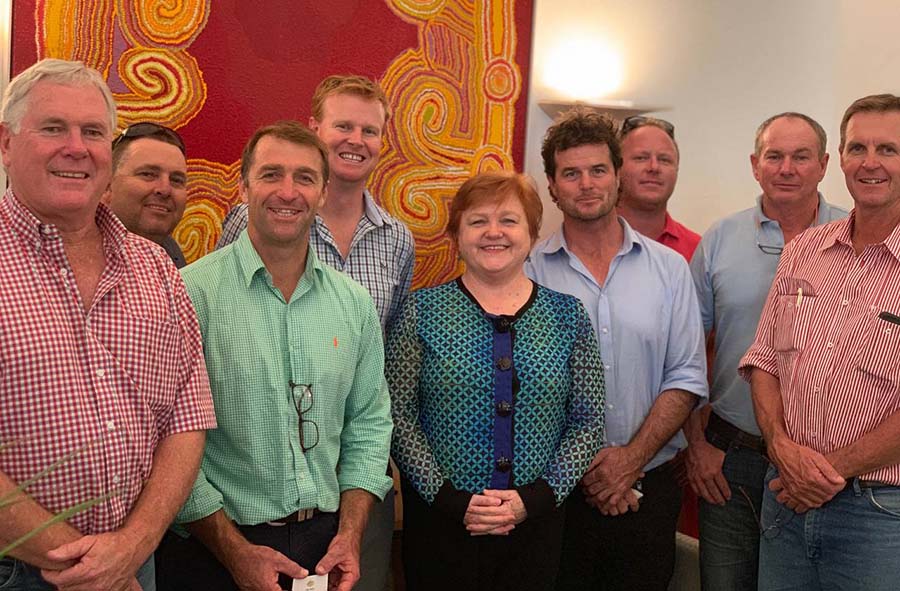A desire to better understand India, Australia's largest market for chickpeas, prompted a group of northern NSW grain growers to travel to that country - and emerging trading partner Bangladesh - earlier this year.
With partial GRDC investment, eight members of the Bellata Farming Group spent two weeks in India and Bangladesh in late February and early March.
Bellata's Drew Penberthy, grower and principal of Penberthy Agricultural Consultants (PenAgCon), and Kevin Schwager, grower and principal of PRIAG Marketing, decided to organise the trip.
With a population of 1.3 billion people, India purchases 84 per cent of its chickpea import requirements from Australia.
"This alone makes India an important trading partner,” Mr Penberthy says.
Chickpeas are one of Bellata Farming Group's most important rotational crops. But India’s decision to impose a 60 per cent import tariff on desi chickpeas at the end of 2017 (through to March 2018) had an immediate impact.
"It stopped Australian chickpea exports to India almost immediately, and as a consequence, Bangladesh and Pakistan have emerged as trading partners," Mr Penberthy says.
GRDC senior manager extension and communication, Luke Gaynor, says the organisation is committed to supporting industry capacity building through the Grower and Advisory Development (GAD) program, which assisted the Bellata Farming Group.
"GRDC appreciates the value of supporting growers and farm advisers in their bid to learn about and better understand the supply chain process," he says.
"This trip also offered Australian industry stakeholders an opportunity to develop relationships with countries, such as India, that helps ensure we are supplying the products their buyers want and need."
On tour
Mr Penberthy says tour's objective was multi-faceted. Production-wise, the group wanted to better understand chickpea farming in a semi-arid climate.

Some of the Bellata Farming Group spent two weeks in India and Bangladesh earlier this year to learn more about chickpea markets. Pictured (L-R) are Kevin Schwager, Drew Penberthy, Ian Gourley, Steven Gleeson, Australian High Commissioner for Bangladesh Julia Niblett, Tim O'Brien, Jock Cameron, Bruce Kirkby and Geoff O'Neill. Phoo: Supplied
He says, from a marketing perspective, the group wanted to learn about consumers' requirements and expectations and help to ensure transparency through the supply chain.
"We visited and held discussions with representatives from the ports, importers, processors, research firms, snack food manufacturers, traders and brokers," he says.
"To better understand the diplomatic relationships between India and Australia, we also held constructive meetings with representatives of the Australian High Commission in both India and Bangladesh."
Market demands
About 220 million people live below the poverty line in India, with another 200 million existing just above that line. With prices excluding animal protein sources, these consumers look to pulses such as chickpeas.
Last year, India produced eight to 10 million tonnes of chickpeas, with Australian imports supplementing demand. About 80 per cent of India's chickpea imports are used for splitting, while the remainder is used for whole chickpea consumption.
Festivals in August and September - and their associated snacks - are peak times for chickpea flour (besan) consumption.Indian tariffs have meant the emerging Bangladesh market is now also important for Australian producers. Bangladesh does not produce chickpeas and requires about 200,000 tonnes annually.
Colour and freshness (current crops) are vital to this market.
Mr Penberthy says learning about key market requirements is hugely valuable to producers, as is an understanding of both cultures and their nutritional needs.
"Otherwise it will cost us market share in these countries," he says.
"Our industry needs to invest time and money in developing new and existing markets, working closer with our customers and providing assistance."
Research
Mr Penberthy says visiting the International Crops Research Institute for the Semi-Arid Tropics (ICRISAT), which is managed by former Narrabri local Peter Carberry, was an inspirational part of the tour.
"Being exposed to multiple facets of research dynamics left us with a much clearer understanding of how Indian farmers manage farms that are two hectares in size," he says.
The group learnt that ICRISAT has 50 chickpea plant breeders and has released about 1000 varieties globally. All chickpeas in India are grown on stored soil moisture, with the first chickpeas planted in October and harvested in January/February.
A second planting occurs in February using varieties with heat-tolerance traits, as the crops flower in temperatures above 35°C. Breeders are working on a heat-tolerant variety that can handle temperatures of 35°C to 40°C during the flowering period.
"The research has left our group with a desire to better collaborate with ICRISAT," Mr Penberthy says.
Future
Working with those in the Indian chickpea supply chain is important for the Bellata Farming Group now and when future protein demands are considered. Yearly per capita chickpea consumption is estimated at 14 kilograms per person, yet nutritional needs are 20kg per person.
"If per capita consumption increased to 20kg, demand for Australian chickpeas could almost double," Mr Penberthy says.
Tariffs
While India's decision to impose a 60 per cent import tariff on desi chickpeas at the end of 2017 was not welcomed by the Australian industry, Mr Penberthy says learning about tariffs was enlightening. Given that agriculture employs more than half the population, there is strong government desire to support farmers.
"And that is often via tariffs on imported chickpeas," he says.
Discussions showed that Australia's reaction to tariffs had frustrated those in the chickpea supply chain.
"It often centres on an expectation that India should reduce tariffs and just simply buy Australian chickpeas."
The Bellata Farming Group were told a much more complex response was needed.
“Australia needs to ask how it can help India meet its nutritional needs, improve food security and protein requirements,” Mr Penberthy says.
India would also like Australia to help in supply chain development.
More information: Drew Penberthy, 0427 255 752, drew@penagcon.com.au

























































